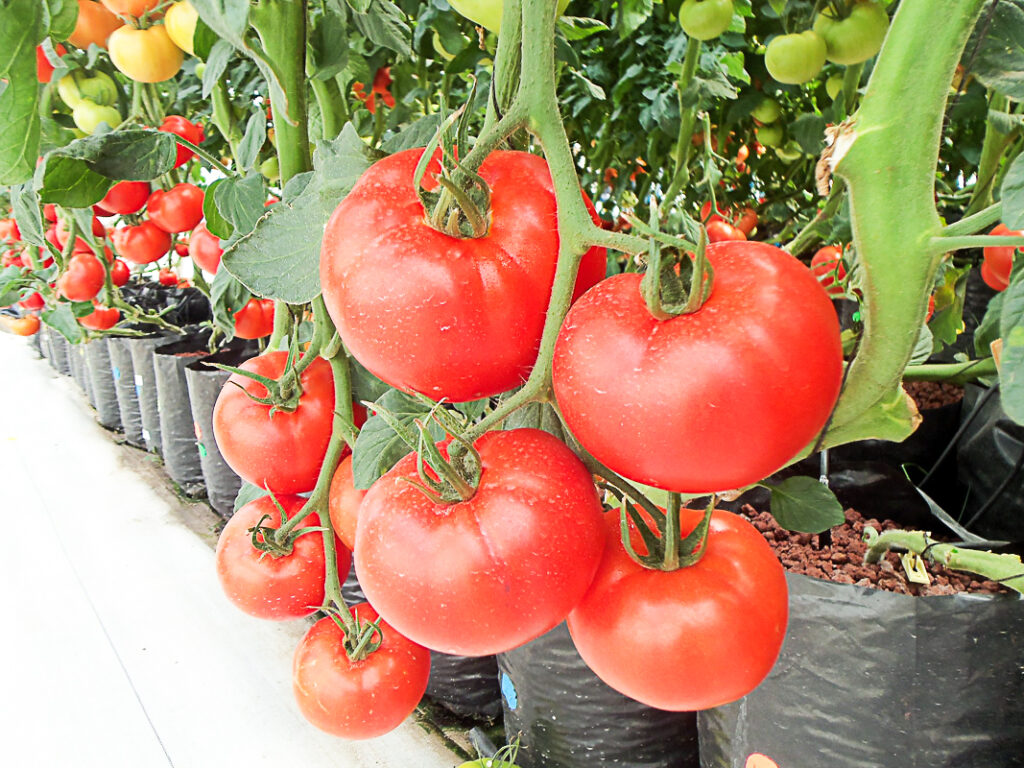Are you a commercial or hobby gardener looking to grow a large number of large plants? Well, a Dutch bucket system might be the answer you are looking for. Simply put, a Dutch bucket system, also referred to as a Bato bucket system, is a hydroponic system where crops are grown in buckets. Here are our tips on how to set one up at home.
*This post contains compensated links. Find more info in my DISCLAIMER. As an Amazon Associate, I earn from qualifying purchases.
Want to start a hydroponic garden at home easily? Check out our recommendations for Best Hydroponics Starter Kits for Beginners.
How Do You Build A Dutch Bucket System?
This system’s setup is a DIY process and can be a good one for beginners. If you can set up a hydroponic drip system on your own, then bucket hydroponics is an easy task.
A dutch bucket system is an ideal system to grow a wide range of different plants. Some of the most popular vegetables include tomatoes, potatoes, cucumbers, peppers, beans, and other vining plants.
The most recommended media for the Dutch bucket hydroponics are media that wick and retain moisture very well. These media include hydroton expanded clay, vermiculite, coco coir, or perlite.
This system uses both space and water efficiently and produces high yields because of good aeration. Though you can use the system to grow small plants, it is highly efficient for larger plants.
The system is flexible to use one, two, or more buckets to line up your plants in rows. One plant is grown in each bucket, but smaller plants can be two in one bucket.

A Dutch bucket system can be put up in greenhouses with adequate lighting and space or outdoors. It would be best if you provide trellises to some plants because they may become top-heavy. These trellises offer support to the plants.
As compared to other systems, the Dutch bucket hydroponics system is the best because it is used to grow large plants, is cost-effective, uses less water and space, and produces higher yields. However, its main disadvantage is that there may be clogs in water lines when the growing medium passes through drippers.
Building a hydroponic system will depend on factors such as your budget, the available space, materials available, and plants to be grown.
Materials Needed For A Dutch Bucket System
To set up your Dutch Bucket System at home, you are going to need all the right pieces. Thankfully, most of what you’ll need can be found at home improvement stores like Home Depot and Lowe’s as well as garden centers. Alternatively, you can source materials online from Amazon.
Pieces you’ll need include:
- Dutch Buckets
- PVC Pipe
- Irrigation drip tube nipples
- Shade Netting
- Black irrigation pipe
- Reservoir
- Growing medium
- Irrigation elbows
- PVC end piece
- PVC elbow
- PVC joint
- Hook screw
- Mounting bolts
- Submersible pump
Tools Needed
There are a few tools you are going to need to assemble your Dutch Bucket System. Don’t worry, all the tools are easily found in home improvement stores. In fact, they might already be in your toolbox. You’ll need a hack saw, power drill and bits, marker, and kettle.
Assembling A Dutch Bucket System
Benches, pellets, or stands are needed to rest the Dutch buckets on. Being a double bucket hydroponics, two buckets are required for every planting pot, i.e., the inner and outer buckets.
The outer bucket gets the overflow in, and you need to drill a hole for the overflow. You can prepare a hole 20mm high to prevent the irrigation elbow from touching the bottom of the bucket.
Cut the black irrigation pipe into pieces in lengths that go approximately to the center of the bucket. You can soak this in warm water for easier insertion of the elbow.
Heat the Dutch bucket and the pipe again so that the pipe can easily be inserted in the bucket and insert the pipe as deep as you can to ensure there are no leaks. Additionally, heat the pipe still sticking out of the bucket and put the elbow outside.
The inner bucket is used to hold plants and the growing media. This bucket needs to have good drainage and should not allow growth medium to fall into the outer bucket. You can achieve this by drilling several small holes at the base of the inner bucket.
Set-up Continued
Cut one sizable piece of the shade netting and put it inside the bucket, and the buckets are now complete. Set up irrigation by mounting the system’s overflow. You start by cutting the PVC into suitable sizes. Join two of the cut pieces using a joining piece and weld using PVC weld glue.
Drill holes so that the overflow can enter the PVC pipe and add the end piece to block one side of the PVC pipe using PVC weld. Drill holes in the benches/pellets/stands and add two u bolts. Ensure your pipe is inclined straight so that water flows with the help of gravity back to the reservoir.
Add the black irrigation pipe to the outer bucket’s elbow and put it inside the overflow PVC pipe.
Sort the inlet drippers. Use black irrigation pipe and then cut it to size. Make holes in the irrigation pipe using tools for mounting the nipples into the pipe. Also, cut the dripper pipe to length and join it to the nipple. Mount the irrigation pipe to the pellets/ stands/ benches using screws.
Next, add the elbow to the side of the pump and connect it to the pump. The pump is now ready to run and can be put in the water reservoir.
Add growing medium to the inner bucket and test the system. It is also recommended to add a filter such as a cheesecloth or w filter bag to the overflow. This is done because there could be possibilities of the growing medium blocking the drippers.
The final product is a running Dutch bucket system. You can add plants of your choice. You can also adjust and add a timer if needed.
N/B: you can add plastic sheeting over the growth medium to prevent excessive sunlight from the system and prevent algae growth. It might also be beneficial to get air stones, and air pumps to have adequate oxygen in the nutrient water.
What Are The Benefits Of A Dutch Bucket System?
Despite issues of clogging water lines, there are several advantages of using this system to grow plants. These include:
Dutch Bucket Systems make it is easy to grow several large plants at once. It is easy to construct and does not consume a lot of space. And best of all the system is highly cost-effective.
It is easy to manage pests and diseases that occur in this system. You simply take out the affected plants and plug the drip hose.
Where To Buy A Dutch Bucket System
You can buy the Dutch bucket hydroponics system on Alibaba or Amazon. The systems go for as low as $150. A Dutch bucket can be purchased for as low as $2.
FAQs – Dutch Bucket System
Because of its design, a Dutch bucket system is ideal for growing a wide range of vegetables especially tomatoes, peppers, and cucumbers.
Most Dutch bucket systems are based on the standard 5-gallon bucket. These buckets measure 14.5 inches in height and have a diameter of 11.8 inches.
Like any garden, plants in a Dutch bucket system need space. A good rule of thumb is 3-5 square feet of space between plants. This allows for enough sunlight and water to reach the plants. Additionally, this space allows for proper airflow preventing infestation.
